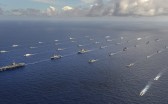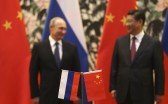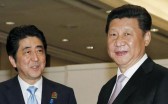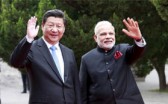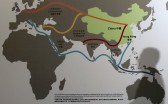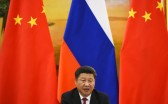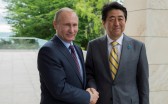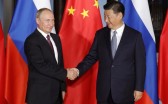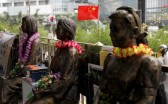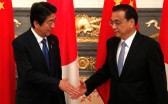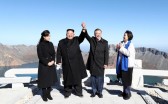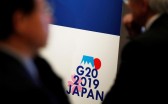Sino-Japan relations, as reported in the mass media over the last several weeks, seem to have positive prospects, accelerated by the fortieth anniversary of the Japan-China Treaty of Peace and Friendship, signed on August 12, 1978 and put into effect on October 23, 1978. It was reported by Japanese media early in August that the Xi Jinping administration was contemplating a political document that describes “new” bilateral relations. This document would become the fifth following the ones signed in 1972, 1978, 1998, and 2008. Prime Minister Abe Shinzo was also reported to have taken a positive step towards better relations, aiming at a visit to China as early as this coming October marking the fortieth anniversary of the Treaty of Peace and Friendship.
In my previous article, I tried to explain how the two countries were drawing closer towards cooperation rather than confrontation in the security arena, and pointed out four specific factors that might have accelerated such positive developments. In the short run, this positive tendency will continue since Xi Jinping seems to have successfully consolidated power, which enables the leader to take a more flexible and pragmatic approach in foreign policy as opposed to a dogmatic and nationalistic approach. The same may apply to Abe Shinzo to some extent. This short piece will cover more geostrategic aspects over a longer term with three viewpoints that are essential to Japan’s orientation of security relations with a rising China in the coming decades.
First, pragmatically speaking, a rising China has good reasons why it needs better relations with the rest of the world. As my earlier piece suggested, the best scenario for China and the rest of the world is a cooperative approach towards a plus-sum game in geographical zones where many actors share common interests such as the Indo-Pacific or the area for China’s Belt and Road Initiative. President Xi Jinping has often mentioned that China needs good relations with its neighbors for sustainable growth towards the achievement of the “China Dream” to become a great China again. China shares land borders with fourteen countries including those with historical causes of possible confrontation such as India, Russia, and Vietnam. China cannot afford hostile relations with them if it is to pursue the continuous success of a peaceful rise.
A worse, if not the worst, case is a confrontational scenario where China and other actors try to expand their influence at the expense of the other side. Examples can be observed when China showed its assertiveness in the South China Sea by the People’s Liberation Army Navy (PLAN)’s aggressive operations and land reclamation in the disputed Spratly Islands. This assertiveness was against Deng Xiaoping’s teaching to “conceal one’s strength and bide one’s time,” and caused harsh reactions from the rest of the world, including the United States, which initiated Freedom of Navigation Operations (FONOPs). Those FONOPs seem to have been successful in denying China’s claims over territorial waters around reclaimed islands as well as its claims over the historical ownership of most of the South China Sea with the “nine-dot line.” As the PLAN currently does not seem to have the capability to oppose such FONOPs, provoking a US operational response would be counterproductive. China may have shown its assertiveness before achieving capabilities to pursue such a policy, resulting in the rest of the world showing their determination to maintain a rule-based international order if China chooses a confrontational policy in regional or global security.
If the PLAN had been far more modernized and powerful, even the US navy could have had serious difficulties in carrying out FONOPs in the South China Sea. Admiral Harry Harris, former commander of the US Indo-Pacific Command, may not have had much difficulty when he conducted FONOPs during his term mainly because US naval and air forces kept strong superiority against any regional forces including the PLA. Air and naval forces of US allies such as Japan, Australia, and the ROK are also among the most modernized in the world. If one looks at major surface combatants, Japan’s Maritime Self Defense Force (JMSDF), despite its compact structure, has robust capabilities even in comparison with the PLAN. According to a London-based think tank’s report “Military Balance 2018,” while the Chinese navy has 18 ships as large or larger than a destroyer (1 aircraft carrier and 17 destroyers), the JMSDF has 38 of them (3 helicopter carriers, 2 cruisers, and 33 destroyers). China’s surface fleet mainly consists of smaller ships such as frigates.
In the context of the military balance between China and other major actors in the world, Japan—along with other likeminded countries—still has good opportunities to hedge against China’s military course of action turning too aggressive, even if Japan is losing opportunities year by year as China continuously rises in military terms. Thus, Japan will have to keep making every effort to shape China’s course of action before it is too late.
Second, Japan needs to keep reminding itself that China is geographically located at the center of the world in both political and economic terms. This point was clearly noted by Secretary of State Hillary Clinton when she wrote an essay in Foreign Policy in November 2011 entitled “America’s Pacific Century,” arguing that the area from the Pacific Ocean to the Indian Ocean “has become a key driver of global politics,” and the United States should keep involved in the region to stand at the central point of the world’s politics. As suggested in the author’s previous essay, the US Indo-Pacific approach, China’s BRI, and Japan’s “Arc of Freedom and Prosperity” all aim at almost the same geographic area, where the future growth of the world’s economy will heavily depend on, even as sources of instability persist.
From a Japanese point of view, its prosperity relies on safe navigation for trade and security with these areas from which Japan imports natural resources and to which it exports its own products. The East China Sea is the area where Japan has to make every effort to avoid any accidental escalation of tension with China around the Senkakus, while it needs to work together with coastal countries such as ASEAN members as well as the United States and other countries that respect the rule-based international order to keep the South China Sea open and safe. Beyond the Malacca Strait, Japan has to cooperate with India and Australia, which have strong geopolitical influence there, along with the United States, the only country in the world that has continuous global reach by air and naval power. China is located in the inner circle of the area mentioned above and can play a crucial role for regional security in either a positive or a negative direction. As sub-regions have different geostrategic characteristics with varying influence of major actors, no country including China can be totally dominant. While China is in the key position, strategic calculations on how much influence it can exercise is extremely complicated depending upon where and against whom.
Third, Japan has to keep in mind that the current historical rise of China is not only new for the rest of the world but also fundamentally new for China in its several-thousand-year history. Historically, China has always been an imperial power except for the time China calls the “century of humiliation,” which started when European powers came into East Asia in the mid-19th century and Japan joined the club of powers in the late-19th century. That was the time when what the modern world describes as nation states started playing a more and more important role in international politics. While Japan was just in time in becoming a united nation state as a result of the Meiji Restoration, due to European and Japanese imperialism, China lost an opportunity to become a nation state to compete with other global actors. Before the “century of humiliation,” China had always been the exclusively dominant power in Asia with Sinocentrism, in which it is located at the central and highest position as something like an owner of a cosmos. With its rise, today’s China is facing a fundamentally new reality where it co-exists as a major power with peer competitors in international politics. It may take some time for China to adapt to this reality and to identify itself within the international order. As China is gigantic, such adaptation may be seen as a challenge to the existing order and cause friction with the rest of the world.
For Japan, one of the states which helped bring about the “century of humiliation,” China’s revival may have significant implications in both positive and negative terms. Up until the first decade of this century, China’s rhetoric against Japan was based on the notion of it being the victim of Japan’s imperialism and militarism. With its drastically risen status, China seems to have changed such rhetoric to that of the victor in WWII. Xi Jinping proudly celebrated the seventieth anniversary of the victory against Japan and fascism in 1945 with a huge military parade in 2015 with international guests including representatives from all G7 countries, except for Japan. On the one hand, with this rhetorical change, Japan may face a more relaxed China coming to acknowledge its greatness, as opposed to a tense China with a more nationalistic attitude centering on resentment. On the other hand, this winner’s rhetoric may lead China to place itself in the position of the only creator of the regional order in East Asia. Japan along with the rest of the world needs to be ready to check China’s attempts to unilaterally challenge the existing rule-based international order. As China reportedly considers signing a political document describing “new” relations with Japan, the government of Japan must make sure that there is no expression implying challenges against the existing rule-based international order.
Conclusion
This article proposes a classical approach in dealing with a rising China that involves both engagement and hedging. Engagement with China towards cooperation on regional and global economy and security is becoming more and more important. As repeatedly mentioned, China’s BRI may have ample room for Japan and the rest of the world to participate to make their businesses plus-sum. China’s sustainable growth will be the key for the health of the world’s economy; it is said that once China sneezes, some countries will catch a cold. The world as a whole wants China to avoid repeating Japan’s experience in the collapse of its bubble economy and needs to cooperate for that purpose. In this context, one serious concern is a debt trap leading to China’s dominant influence in countries funded by it for projects that are not profitable enough to make repayments. While China’s dominance in regions where many other actors have a stake is bad news, worse news is that unchecked investment for infrastructure building may cause the creation of failing and failed states in such regions.
As to a rule-based international order in the maritime arena in particular, more and more actors are becoming interested in respecting it and involved in actions to preserve it. While US FONOPs have already been mentioned, US allies and partners such as the United Kingdom, France, and Australia are sharing the same idea by sending naval vessels to the South China Sea and Western Pacific. India’s “act east” policy has led it to send its fleet to this region regularly in the last several years. Japan’s efforts to build capacity in ASEAN member states for maritime security are an example of a new type of regional cooperation. The key is determination among likeminded countries such as Japan, the United States, as well as US allies and partners to oppose any attempts by China to change the status quo by power, to firmly establish common rules for the open seas, and to spread widely an understanding of the importance of the rule-based international order.
